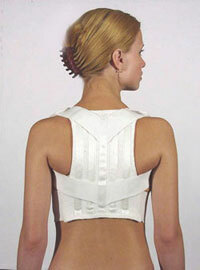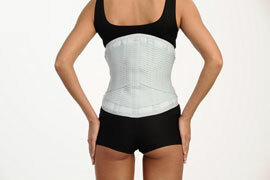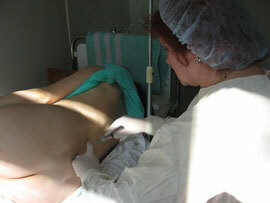It can be on the one hand, but there are also two-sided inguinal hernia. Sometimes( rarely) such hernias are cured spontaneously.
Prevalence: this pathology occurs in 2% of the total number of children. More often inguinal hernia occurs in boys, especially, the first year of life.
The causes of inguinal hernia in children
First, the formation of inguinal hernia is due to anatomical features of the structure of the anterior abdominal wall .In the groin area it passes the inguinal canal, which is formed by the external and internal oblique and transverse abdominal muscles, as well as their aponeuroses. This channel is the weakest point of the anterior abdominal wall and any increase in pressure in the abdominal cavity( strong screaming, crying, lifting of gravity) can provoke the bulging of the contents of the abdominal cavity through this formation. In addition, in children, the inguinal canal and muscles are weaker than in adults.
Secondly, children often have a vaginal process of the peritoneum that is not infected, through which protrusion occurs.
Inguinal hernia in both children and adults has the following elements:
-
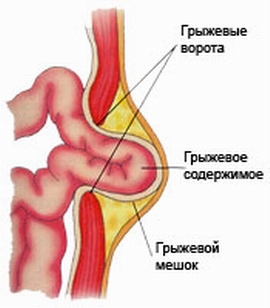 hernia gates;
hernia gates; - hernial sac;
- contents of the hernial sac.
Classification of inguinal hernias
Inguinal hernias are:
- straight / oblique;
- is correct / unrecoverable;
- restrained / not restrained.
Direct hernia is acquired. It is located in the so-called Kisselbach triangle, just above and outside of the pubic area. This place corresponds to the location of the inguinal canal( external inguinal opening).It arises from the weakness of the fascia of the transverse abdominal muscle with a sharp increase in intra-abdominal pressure due to coughing, constipation, obesity, and strength loads. It is more common in the elderly. Can be double-sided. Usually the inguinal hernia contains loops of the small or large intestine or part of the omentum( the fat layer covering the intestine in front).In girls in a hernia, an ovary with a fallopian tube can be found.
Slanting hernia or inguinal and scrotal hernia in children is often congenital, but can be acquired. It is located below the straight line, in some cases can reach the testicle. This is connected with the following. In the ontogenesis of the human body, the testicle first settles in the abdominal cavity, then it gradually protrudes into the inguinal canal together with the appendage of the peritoneum. Passing the inguinal canal, it descends into the scrotum. In this case, there remains a process of the peritoneum, which is stretched from the abdominal cavity to the scrotum. Over time, this vaginal appendage of the peritoneum should coalesce, but in a number of cases this does not happen. In this case, the risk of developing such diseases as oblique inguinal hernia and hydrocele( a fluid that lubricates the abdominal cavity through the uninjured vaginal process of the peritoneum drains downward into the scrotum, causes its increase).
Reachable inguinal hernia can be reversed. This can be done either manually or by pulling the patient's stomach.
Unrecoverable hernia can not be corrected by any means( due to the development of adhesions in it or for other reasons).
Uninhibited inguinal hernia is a hernia that does not cause acute danger and does not require emergency surgery.
Restricted inguinal hernia, on the other hand, is a dangerous complication in which ischemia occurs( a violation of blood supply) of organs contained in the hernial sac. In the absence of emergency surgical care, gangrene of the intestine, peritonitis and death of the patient may develop.
Symptoms of inguinal hernia in children and its diagnosis
Externally, inguinal hernia appears in the form of protrusion in the Kisselbach triangle above and outside of the pubis( a direct hernia) or above the scrotum( oblique hernia). With crying, screaming, movements of the child, this protrusion can become larger. It can be corrected by pressing it with your hands( if the hernia is corrected).Often inguinal hernia in children is accompanied with an increase in the scrotum( dropsy testicles or inguinal and scrotal hernia).
If the inguinal hernia is infringed, there will be a sharp pain in the groin, nausea, vomiting, muscle tension in the anterior abdominal wall, especially near the protrusion of the hernia. If the hernia was corrected, it sharply becomes irreparable, painful on palpation. Perhaps stihanie pain a few hours from their occurrence, but the child at the same time becomes exhausted, listless, pale, complains of poor health, malaise.
If you suspect an inguinal hernia, parents should contact a pediatric surgeon. As the scrotum grows, it should be referred to urologists. But, as a rule, they work side by side and they have one receiver.
Diagnosis is performed using ultrasound, which allows visualization of the contents of the inguinal canal and hernial protrusion
Treatment of inguinal hernia in children
Conservative treatment is performed only with uninfected hernias in children under 4 years old. In this case, treatment is done to strengthen the muscles of the anterior abdominal wall by means of physiotherapy exercises, abdominal massage, various games with children.
If infringement of an inguinal hernia occurs, then emergency hospitalization in the children's surgical department and surgery is indicated. In this case, other conservative treatment is contraindicated. Do not give the child antispasmodics, painkillers, to do a warm compress over the hernial region.
The operation is not permissible if the child has severe cardiovascular and respiratory insufficiency, active tuberculosis, malignant neoplasm. In this case, the hernia is treated conservatively without surgery.
Operation in inguinal hernia in children
At the moment, there are two main operations to remove inguinal hernia in children. One of them implies tightening the hernial gates with the body's own tissues, and the other - by installing a special polypropylene mesh that strengthens the weak area of the anterior abdominal wall. Each of these operations has its pros and cons and various clinics prefer this or that operation.
Minus polypropylene mesh is that it is a foreign body in the body and it is often possible to develop its suppuration with subsequent loss. In this case, you need to perform a second operation.
Minus the same operation without a grid is the higher frequency of relapses. Although this frequency will depend on the qualification of the operating surgeon, that is, on the quality of the performed operation.
Anesthetic
These operations require anesthesia. As a means for anesthesia use sedatives, narcotic analgesics and hypnotics( intravenous or inhalation). To reduce the doses of these drugs, the site of operation is abundantly cured by local anesthetics, such as novocaine and its analogs.
Course of operation
First cut the superficial tissues over the hernia, open it. Assess the viability of injured organs in the hernial sac. For a more adequate evaluation, they are covered for 5-10 minutes with napkins moistened with a warm saline solution. If they turn pink and "come to life" on gases, then the hernia gates relax and direct it back. Otherwise, with necrosis of the organs in the hernial sac, they are removed and the intestines are sewn together( anastomosis).After this, the hernia gates are either tightened with the help of surrounding tissues and threads, or a polypropylene mesh is inserted, lacing it to the anterior abdominal wall. Then they cover the skin and apply a bandage.
After operation
The operation for a child is very difficult, but the child is discharged, as a rule, on the same day after the operation. But thus he should be at home within two weeks that there was no relapse and seams which remove in a week have not dispersed.
Video: A hernia in a child
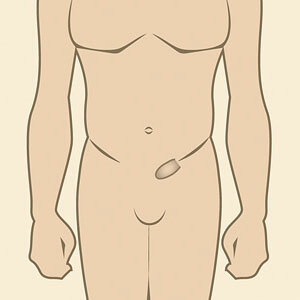 Inguinal hernia in children is a protrusion of the contents of the abdominal cavity through the inguinal canal.
Inguinal hernia in children is a protrusion of the contents of the abdominal cavity through the inguinal canal.

